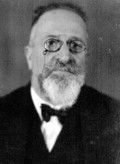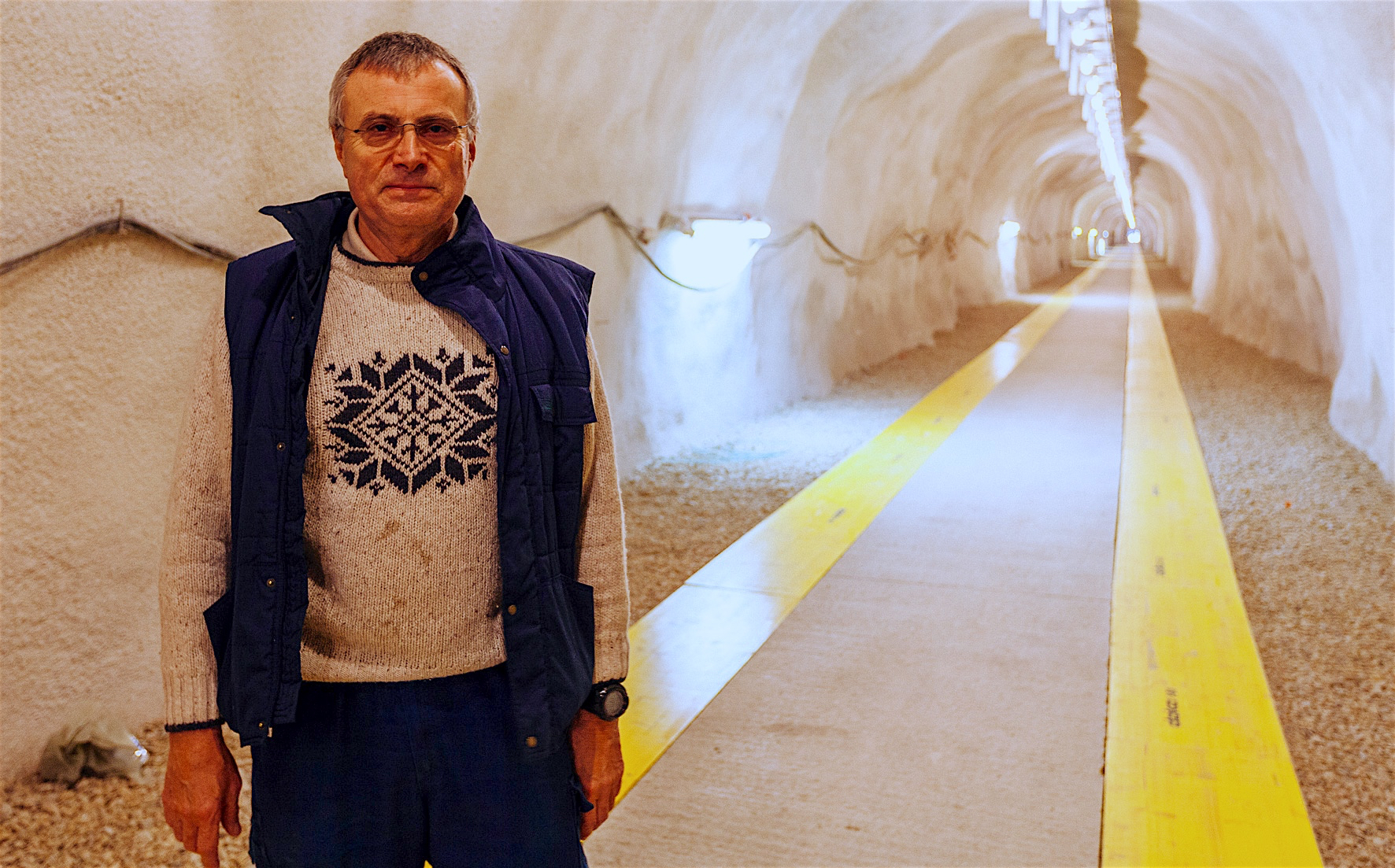Named after Victor Conrad
The Trafelberg observatory is named after the Austrian geophysicist Victor Conrad. Victor Conrad was born on August 25, 1876 in Vienna into an upper-class Jewish family. Conrad studied physics at the University of Vienna and wrote his dissertation at the Physical-Chemical Institute under the physicist Franz-Serafin Exner. After receiving his doctorate in 1900, he was employed at ZAMG as a university assistant from 1901. In 1904 the earthquake service was set up at ZAMG, and Victor Conrad was appointed its first head and at the same time adjunct professor at ZAMG. In 1906 Conrad received the venia legendi for meteorology at the University of Vienna. In 1910 Conrad was promoted to Associate Univ.Prof. of Cosmic Physics at the Franz Joseph University in Chernivtsi (today in the Ukraine). From 1911 to 1914, Conrad organized the new Institute for Cosmic Physics and the observatory there. He lectured on terrestrial physics, astronomy, climatology, weather forecasting and seismology.

Fig. 1: Victor Conrad
After the collapse of the Austro-Hungarian monarchy at the end of 1918, most of the German professors had to leave Czernowitz at the end of July 1919, including Conrad, under "[...] loss of the professorship, property and fortune [...]" The planned appointment as professor on 1.1. 1919 was not carried out, Conrad was reinstated as an official in the position of head of the Seismological Service. Conrad always found it humiliating that he was assigned the position of civil servant and not that of university professor. It was not until 1926 that Federal President Michael Hainisch gave him the title of full university professor.
Conrad persistently tried to gain a foothold in the Republic of Austria at the university - in 1919 his venia legendi was renewed. Anti-Semitic discrimination occurred in 1923 when he applied for the vacant chair in meteorology and geophysics at the University of Graz to succeed Heinrich Ficker. The commission to fill the chair again justified the non-consideration of Conrad in the proposal for the appointment as follows:
"[...] Prof. Conrad is Jewish and his appointment would encounter serious resistance from the Graz student body [...] the commission sees no nomination for Dr. Conrad and confines there proposal to the other three scholars cited. […]".
In the publication "Propagation time curves of the Tauern earthquake of November 28, 1923" (1925), Conrad described the observation of P waves, which finally led him to the conclusion of a 2-layer structure of the earth's crust. The interface of these layers later became known as the "Conrad discontinuity". In 1926, when Conrad became the editor of "Gerland's Contributions to Geophysics" - one of the oldest journals in this field (since 1887) - the journal advanced to become the most important international publication for geophysical research.
In 1934 Conrad was suspended from the ZAMG "with a waiting fee". This abrupt dismissal took place on April 30, 1934 - Conrad was 58 - in 1936 he retired. Conrad gave his last lecture at the University of Vienna in winter semester 1937/38 on "Precipitation and Sunshine on Earth".
After the Nazis came to power in 1938, the prominent German seismologist Beno Gutenberg – who had been a professor of geophysics at the California Institute of Technology in Pasadena since 1930 – maintained his contacts in Germany. He helped many Jewish scientists from Germany and Austria to emigrate to the USA, including Victor Conrad; Gutenberg's guarantee ("affidavit") for Conrad was essential for his emigration and thus for his survival.
From 1939 to 1940 Conrad worked successfully at the Pennsylvania State University, Department of Meteorology, from 1940 to 1942 at New York University, at the California Institute of Technology, at the University of Chicago and finally from 1944 to 1951 at Harvard University in Cambridge , Massachusetts.
Conrad's scientific life's work includes more than 240 essays on meteorology, climatology and seismology.
A legacy for Science
Victor Conrad died in 1962 at the age of 86 in Cambridge, Mass. In her will, his wife Ida (1880-1969) deliberately orders a legacy to the ZAMG with the wish "... that a building be erected from the estate that serves geophysical or meteorological research and bears the name of Victor Conrad." The financial cornerstone for building an observatory was laid with this generous donation.
In 1975 Peter Melichar was commissioned by the Central Institute for Meteorology and Geodynamics to find a suitable location for a new geophysical observatory. The order included the planning and construction of an observatory that also meets the specific requirements of scientific research in the fields of seismology, geomagnetism and gravimetry. In addition, the observatory on the Cobenzl on the outskirts of Vienna, which was built around 1952, had to be replaced due to the severe disruption caused by the big city. After an intensive search, in 1979 the choice fell on the Trafelberg in Lower Austria at 1,100 m above sea level. The absence of natural and man-made disturbances, such as ground movements and electromagnetic fields, was decisive for the choice of location.
The site also requires a geological subsoil that largely contains massive and non-magnetic rocks over large areas. The Trafelberg has all these characteristics and is today a forest reserve that is only accessible via a forest road that is closed to public traffic. The immediate protection area of the observatory covers 450 hectares and is not populated. Peter Melichar chose an underground construction in order to be able to optimally carry out the standard tasks of a geophysical observatory as well as basic research in the Alpine region. In addition, there are six underground accessible boreholes in the tunnel system with a total length of 700 m.
However, it would be years before construction work on the seismic-gravimetric portion of the Conrad Observatory could finally begin in 1998, thanks to the tireless efforts of Peter Melichar. The generous bequest to the Central Institute for Meteorology and Geodynamics through the legacy of Ida Conrad and the large subsidies from the state of Lower Austria formed important foundations. This external financial support finally made it possible for the Federal Ministry of Science and Research to build the Conrad Observatoium at this excellent location.

Fig. 2: Peter Melichar, Head of the Geophysics Department and Director of the Observatory from 1991 to 2009, in the GMO tunnel. (Credit: Bernhard Wieland)
2002 Opening of the First Construction Phase: the Seismic-Gravimetric Observatory
The seismic-gravimetric observatory SGO started regular operation in 2002. After that, measuring instruments for a wide range of geological disciplines were gradually put into operation. A milestone in 2002 was the first high-precision and undisturbed seismic measurement results in the SGO tunnel. In the years that followed, various seismic sensors were installed and tested. These new developments and constructions were decisive for the construction of the seismic station network in Austria and in the neighboring countries. Measurements are taken continuously on special pedestals in boreholes and in a shaft on the observatory premises. Another important milestone in 2007 was the commissioning of the superconducting tide gravimeter, together with the University of Vienna. Meteorological sensors, which support the data from the gravimetric evaluations, were installed outside the SGO in these years. In 2009, after a long planning period, four infrasound test and calibration systems were set up and put into operation in the area of the SGO for the Comprehensive Nuclear-Test-Ban Treaty Organization CTBTO.

Fig. 3: The entrance area to the SGO (Credit: Gerhard Ramsebner)
2014 Opening of the Second Construction Phase: the Geomagnetic Observatory
Peter Melichar retired at the end of 2009. From February 2010, Roman Leonhardt took over the management of the Conrad Observatory. In April 2010, construction work for the GMO began. Based on the first full year of data in 2015, the observatory was certified as an INTERMAGET observatory in 2016 for its outstanding data quality and availability according to international criteria. During the construction work from 2012, the first magnetic field sensors in the GMO were put into operation for test purposes. These measurements were of course still disturbed by the construction work. In the years after completion, numerous other measuring systems and prototypes from a wide variety of disciplines were added.
Below you will find a short list of important milestones. Numerous systems have been installed together with or by national and international partners. For details, please refer to the relevant project and infrastructure pages.
Measuring systems in the area of the SGO:
From 2002, installation of broadband and strong motion seismometers in the tunnel on several bases and in a borehole.
2007 Tidal Gravimeter.
2008 Development and installation of the CALTAB_1 calibration system for seismometers.
2010 Measurements of natural radioactivity
2010 Construction of a meteorological station - METLIFT.
2012 Snowpack Analyzer and Rain Radar.
2016 Installation of a tilt sensor in the SGO tunnel.
2022/2023 Renewal of the superconducting gravimeter.
2023 Installation of a Trillium-360 borehole seismometer.
Measuring systems in the field of GMO:
2009 Construction of a non-magnetic wooden house in the area between SGO and GMO, to check all building materials for their magnetic properties on site during the construction phase of the GMO.
In 2010 and 2014 there was an open day at the Conrad Observatory. Around 700 visitors visited the observatory. After completion of the construction work in the GMO and also in the SGO, no further visits were carried out in order not to disturb the continuous measurements.
2013 Recording of the first magnetic absolute measurements with the standard instruments intended for this purpose.
2014 Commissioning of the paleomagnetic laboratory.
2015 Commissioning of the GEM 3D supergradiometer magnetometer equipped with 9 sensors in the entire tunnel area.
2015 Installation of an induction coil system to record high-frequency magnetic phenomena.
2017 Commissioning of the Merritt coil system for calibrating magnetic field sensors.
2017 Schwaz in Tyrol and 2018 Gams in Styria - construction of magnetic field measuring stations to record magnetic field variations.
2018 The international 18th IAGA workshop for geomagnetic observatories with a first-time summer school for young observators in the GMO.
2022 The Cavendish Project.

Fig. 4: Laboratory building of the GMO (Credit: Lois Lammerhuber)
The observatory with all the associated equipment and systems is used for continuous seismic, gravimetric and geomagnetic observation and is now a place for top-level scientific research at an international level.
Quotations and further reading:
Hammerl, C., Lenhardt, W., Steinacker, R. und P. Steinhauser (Hg.): Die Zentralanstalt für Meteorologie und Geodynamik. 150 Jahre Meteorologie und Geophysik in Österreich (Graz 2001) 838 p.
Hammerl, C. und M. Staudinger: 170 Jahre Zentralanstalt für Meteorologie und Geodynamik. (Graz 2021) 152 p.


